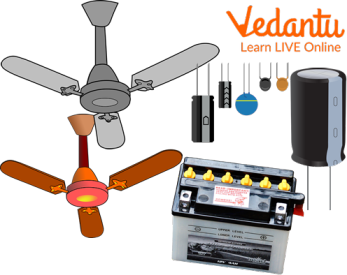




Overview of Capacitor
The majority of electronic equipment uses capacitors as essential parts. They are extensively utilised in electrical loads, power supply units, and electronic circuits. Along with resistors and inductors, capacitors are one of the "Big Three" passive components that make up fundamental electronic circuits.
In order to filter out erroneous electric impulses and stop harm from electric surges to delicate parts and circuits, capacitors play another more crucial function. We will read about the uses of capacitors in detail in this article. So, let's get started learning about this fascinating topic. Read ahead!
What is a Capacitor?
A capacitor is a device that stores energy in the form of electric charge. A capacitor's energy storage capacity is around 10,000 times smaller than that of a battery of the same size, yet it is still useful for a wide variety of circuit designs.
A capacitor is made from two metal plates that are separated by a substance called the dielectric. The dielectric can be constructed of any type of insulating material, such as paper, glass, ceramic, or anything that prevents the flow of current, whereas the plates are conductive and typically made of aluminium, tantalum, or other metals.

Different Types of Capacitors
Uses of Capacitors
A capacitor is a device used to store electrical energy. It is an electrical component which has two terminals. There are many applications of capacitors, how about reading them one by one? Let’s have a look!
Bypass (Decoupling) Capacitors
Bypass or decoupling capacitors are typical examples. They are frequently used with electronic components and positioned between the IC's power source and the ground.
Converter from AC to DC
DC adapters are another common application for capacitors. Diode rectifiers are frequently used to convert AC voltage to DC voltage, however, they are ineffective without the aid of capacitors.
Filtering of Signals
A different use for capacitors is in signal filtering. They can block low-frequency sounds while enabling high frequencies to flow through due to their precise response time.
As Sensors
Capacitors are employed as sensors to measure a wide range of things, such as fuel levels, mechanical strain, and atmospheric humidity. The structure of a gadget affects its capacitance.
Relays for Power Conditioning
The conditioning power supply is a crucial application for capacitors. When charged, capacitors block DC signals but let through AC signals.
Applications of Capacitor in a Fan
When you turn off the ceiling fan, you might have noticed that it doesn’t stop immediately; this is because the capacitor inside the fan will be discharging the energy. An average ceiling fan motor has two capacitors. The "start" capacitor is the first, and the "run" capacitor is the second.
For an AC motor to turn the motor shaft, there must be a revolving magnetic field (fan blades). This is accomplished by providing voltage with various phase combinations to various windings. There will be only a voltage phase in a single phase, such as the one in your home where a ceiling fan would be used. The capacitor is employed to give the motor's windings a phase shift, or a temporal offset between currents, creating the illusion that the motor is working in a multiphase system.

Role of Capacitor in a Fan
What does Capacitor do?
A capacitor is a device used to store the charge. It stores the charge between the two plates it consists of. It suppresses DC voltages.
It transmits AC voltages or signals; the greater the frequency permitted for transmission, the smaller the capacitance. The frequency that can pass depends on how big the capacitor is;
Unlike a battery, which can almost appear to be a battery for tiny current discharges, a supercapacitor keeps a charge but does not have a huge energy storage capacity;
You could add a few more suggestions to the list above by utilising multiples and connecting them to resistors, inductors, and other components, such as doing things like only allowing a specific frequency (or band) to go through or removing noise, as mentioned in previous articles. Our technology would be far more fundamental and constrained without capacitors.
Summary
In this article, we learned various important facts about capacitors. We learned that The purpose of a capacitor is to store electrical energy. Additionally, the capacitor serves as a filter, allowing alternating current (AC) while obstructing direct current (DC). In a circuit schematic, a capacitor is represented by this symbol. Two electrode plates facing each other but separated by an insulator make up the capacitor's construction.
We also learned that each electrode on the capacitor stores an electric charge when a DC voltage is applied. Current flows as the capacitor are charged. When the capacitor is fully charged, the current will stop. Isn’t this article an answer to why use capacitors? We think it was since you have learnt the uses of capacitors above.
FAQs on Uses of Capacitor
1. What are the main uses of a capacitor in electronic circuits?
A capacitor is a versatile component with several primary uses in electronic circuits. Its main applications include:
- Energy Storage: Temporarily holding electrical energy and releasing it when needed.
- Power Conditioning: Smoothing out variations in a DC power supply to provide a stable voltage.
- Signal Filtering: Blocking direct current (DC) while allowing alternating current (AC) to pass, which is essential in audio and radio circuits.
- Timing: Working in conjunction with resistors to create timing circuits that control the duration of events.
- Motor Starting: Providing an initial boost of energy to start single-phase motors, such as those in fans and air conditioners.
2. What are five key functions of a capacitor in a typical electronic device?
In a typical electronic device, a capacitor performs five critical functions:
- Power Supply Smoothing: After an AC-to-DC converter, a capacitor filters the pulsating DC into a steady supply.
- Decoupling: It stabilises the voltage supplied to integrated circuits (ICs) by filtering out high-frequency noise.
- Signal Coupling: It passes AC signals from one stage of a circuit to another while blocking any unwanted DC offset.
- Sensing: It can be used as a sensor where a change in a physical property (like pressure or humidity) alters its capacitance.
- Energy Buffering: It stores a small amount of energy to supply a circuit during brief moments of high power demand, like in a camera flash.
3. Where can we find capacitors in our everyday household appliances?
Capacitors are essential components in many household appliances. For example, you can find them in:
- Ceiling Fans and Air Conditioners: A capacitor is used to create a phase shift in the motor's winding, which helps it start and run efficiently.
- Phone Chargers and Laptop Adapters: They are used to smooth the rectified DC output, converting the wall's AC power into stable DC power for charging.
- Audio Systems and Speakers: They act as filters in crossover circuits, directing high-frequency signals to the tweeter and low-frequency signals to the woofer.
- Televisions and Computer Monitors: They are used extensively in power supply and signal processing circuits.
4. What is the specific role of a capacitor in a ceiling fan motor?
The main role of a capacitor in a single-phase ceiling fan motor is to create a rotating magnetic field. A single-phase AC supply can only produce a pulsating magnetic field, which is not enough to start the motor's rotation. The capacitor is connected to an auxiliary winding in the motor, creating a second current that is out of phase with the main current. This phase difference creates the necessary rotating magnetic field to provide starting torque and keep the fan blades turning smoothly.
5. How is a capacitor fundamentally different from a battery?
Although both store energy, a capacitor and a battery are fundamentally different. A battery stores energy chemically through an electrochemical reaction and releases it slowly. In contrast, a capacitor stores energy physically in an electrostatic field between its plates. This allows a capacitor to charge and discharge extremely quickly but hold significantly less energy than a battery of a similar size. Batteries provide a steady voltage, while a capacitor's voltage drops as it discharges.
6. Why can a capacitor block DC but allow AC signals to pass through?
This behaviour is due to how a capacitor reacts to changing voltage. For a DC signal (constant voltage), the capacitor charges up once, and then no more current can flow through it, effectively blocking the signal. For an AC signal (continuously changing voltage), the capacitor is constantly charging and discharging as the current direction reverses. This continuous process of charging and discharging allows the alternating current to effectively "pass through" the circuit. This property makes capacitors ideal for filtering and coupling applications.
7. What would happen to a computer motherboard if its decoupling capacitors failed?
Decoupling capacitors on a motherboard are placed near sensitive components like the CPU to filter out high-frequency noise from the power supply lines. If these capacitors failed, the CPU and other integrated circuits would be exposed to unstable voltage and electrical noise. This would lead to unpredictable system behaviour, such as data corruption, random system crashes, blue screens, or a complete failure to boot. In severe cases, the voltage spikes could cause permanent damage to the components.
8. How does the dielectric material between the plates of a capacitor influence its applications?
The dielectric material is crucial as it determines a capacitor's key characteristics and, therefore, its applications. It influences the capacitance value, voltage rating, and stability. For example:
- Ceramic dielectrics are used for high-frequency applications like decoupling because they have low losses.
- Electrolytic capacitors (using an oxide layer as a dielectric) offer very high capacitance in a small volume, making them perfect for power supply filtering, but they are polarised.
- Polymer film dielectrics offer high precision and stability, making them suitable for timing and filter circuits where accuracy is important.









